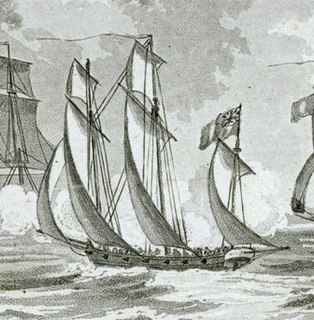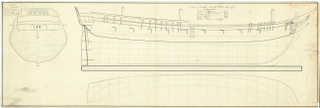HMS Hermes was a 20-gun Hermes-class sixth-rate flush-decked sloop-of-war built in Milford Dockyard to the lines of the ex-French Bonne Citoyenne. She was destroyed in 1814 to prevent her falling into American hands after grounding during her unsuccessful attack on Fort Bowyer on Mobile Point outside Mobile, Alabama.
Two vessels served the British Royal Navy as His Majesty's Hired armed cutter Hero. Under the command of Lieutenant John Reynolds, the second hired armed cutter Hero captured some 30 merchantmen during the Gunboat War before the Royal Navy returned her to her owners. She was so successful that the Norwegian merchants offered a considerable reward for Hero's capture.
His Majesty's hired armed cutter Ann served the British Royal Navy from 9 May 1795 to 19 October 1801 during the French Revolutionary Wars. She was of 10491⁄94 tons (bm) and carried twelve 3-pounder guns.
His Majesty's hired armed cutter Courier appears twice in the records of the British Royal Navy. The size and armament suggests that both contracts could represent the same vessel, but other information indicates that the second Courier had been captured from the French in the West Indies. On the first contract the captain and crew were awarded clasps to the Naval General Service Medal, one for a boat action and one for a single ship action in which they distinguished themselves.
His Majesty's Hired armed cutter Tartar served the Royal Navy from 14 July 1794 to 11 November 1801. She was of 9063⁄94 tons (bm) and was armed with twelve 4-pounder guns.
During the French Revolutionary and Napoleonic Wars, British vessels captured at least 12 French warships and privateers named Espoir, which means “Hope” in French. In only one case was there mention of an exchange of fire or casualties. In general, the privateers tried to escape, and failing that surrendered.
The French lugger Affronteur was launched in 1795 and in 1796-7 participated in the Expédition d'Irlande. In 1803, HMS Doris captured her and she subsequently served the Royal Navy either as a commissioned vessel or, more probably, as His Majesty's hired armed brig Caroline. In 1807 she was either broken up, or became a letter of marque.
At least two vessels known as His Majesty's hired armed lugger Nile served the Royal Navy during the French Revolutionary and Napoleonic Wars. These may have been the same vessel on sequential contracts.

His Majesty's hired armed vessel Aristocrat served the Royal Navy, twice, as a lugger from 1794 to 1798, and as a brig from 1799 to 1801. She served with the Jersey-based Channel Islands flotilla under Commodore Philippe d'Auvergne, Prince of Bouillon. As a lugger she participated in two notable engagements, the second of which won for her crew the Naval General Service Medal, awarded some 50 years later. As a brig, she captured two privateers.
Two vessels have borne the designation, His Majesty's hired armed cutter Lion. The first served during the French Revolutionary Wars, capturing five privateers and several merchant vessels. The second served briefly at the start of the Napoleonic Wars. Both vessels operated in the Channel. The two cutters may have been the same vessel; at this juncture it is impossible to know. French records report that the French captured the second Lion in 1808 and that she served in the French Navy until 1809.

The French gun-vessel Eclair was one of 20 chasse-marées built in 1785 in southern Brittany for use as service craft in harbour construction at Cherbourg. In 1793 Martin or Jacques Fabien converted ten of them into chaloupes-canonnières (gun-vessels). One of these received the name Eclair. Sir Richard Strachan's squadron captured her in 1795 in Cartaret Bay, and the Royal Navy took her into service as HMS Eclair. She then sailed to the West Indies where she was probably out of service by 1801. In 1802 she was hulked under the name HMS Safety. She then served as a prison ship at Jamaica around 1808 to 1810. She may have been sold at Tortola in 1817/18, but in 1841 or so was brought back into service there as a receiving hulk. She was broken up in 1879.

The French brig Suffisante was launched in 1793 for the French Navy. In 1795 the Royal Navy captured her and took her into service under her existing name. HMS Suffisante captured seven privateers during her career, as well as recapturing some British merchantmen and capturing a number of prizes, some of them valuable. She was lost in December 1803 when she grounded in poor weather in Cork harbour.
His Majesty's hired armed schooner Lady Charlotte served the British Royal Navy on contract between 28 October 1799 and 28 October 1801. She had a burthen of 120 85⁄94 tons (bm), and was armed with twelve 12-pounder carronades. As a hired armed vessel she captured several privateers and recaptured a number of British merchant vessels. After her service with the Royal Navy, she apparently sailed as a letter of marque until the French captured her in 1806.
Two vessels named His Majesty's hired armed lugger Sandwich served the British Royal Navy, one during the French Revolutionary Wars, and the other during the Napoleonic Wars.
Two vessels named His Majesty's Hired armed cutter Industry briefly served the British Royal Navy during the Napoleonic Wars as hired armed vessels.
Two vessels named His Majesty's Hired armed cutter Adrian served the British Royal Navy during the Napoleonic Wars as hired armed vessels.
His Majesty's hired armed vessel Marechal de Cobourg served the British Royal Navy under contract during the French Revolutionary Wars. Contemporary records also referred to her as Marshall de Cobourg, Marshall Cobourg, Marshall Cobourg, Marquis Cobourg, Marquis de Cobourg, Cobourg, Coborg, and Saxe Cobourg. Further adding to the difficulty in tracking her through the records, is that although she was originally a cutter, later the Navy converted her to a brig.
The Royal Navy purchased HMS Barracouta on the stocks in 1782. After she had served for almost ten years patrolling against smugglers, the Navy sold her in 1792. She became the privateer Thought, which had a successful cruize, capturing several prizes including a French privateer, but then was herself captured in September 1793. She served the French Navy under the names Pensée, Montagne, Pensée, and Vedette, until the British recaptured her in 1800 and renamed her HMS Vidette. The Royal Navy sold her in 1802.
Resolution was a privateer lugger operating out of Guernsey in 1793. She made several captures, most notably of the French East Indiaman St.Jean de Lone.
Battalion was launched at Whitby in 1795. She traded with the Baltic and then in 1796 became a Liverpool-based West Indiaman. A French privateer captured her in 1797 as she was outbound on her first voyage to Jamaica. The Royal Navy quickly recaptured her. She was last listed in Lloyd's Register (LR) in 1797.